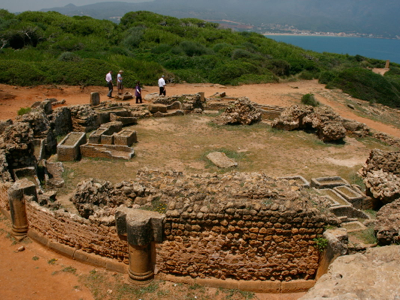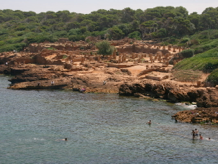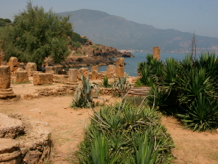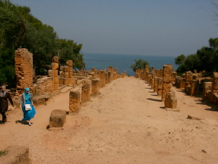North Africa ‘Plus’ Travel Diary

2011
Turkey Tunisia Algeria Iran Transnistria
The weather did not look promising when the alarm sounded this morning at 6:15 am. The dawn glow revealed a thick cover of grey clouds that was quite the opposite of my expectations of North Africa in summer. Nonetheless, we had our breakfast of surprisingly sparse fare - some French bread with toast and a carton of yogurt with a glass of orange juice - and prepared to spend our first full day in Algeria in Tipaza (sometimes spelt Tipasa), about 70 kilometres west of Algiers.
We were collected by Badjou and Zarina at 8:15 am, and we began the journey west. The scenery was fairly unremarkable as we followed the coast, passing through nondescript small towns, except for the number of police check points. There were police checks every few kilometres for the duration of the drive, and the fact that the police were all wearing thick bullet-proof vests led my mind through an interesting range of questions, such as how bad can road rage be in Algeria, is shooting traffic police a serious threat in Algeria, and so on. Badjou told us that the bullet-proof vests were a remnant of an earlier decade of unrest, but that although no longer needed, they had just become part of the uniform.
Tipaza is an ancient settlement, and the ruins of the city that are built right on the coast are a great sight. The city was first established by the Phoenicians in the 5th century BC. It became a Roman city during the 1st century, taking on a role role as a strong centre of Christianity during the 3rd century. The city was sacked by the Vandals towards the end of the 4th century, and despite a brief resurgence as part of the Byzantine Empire, the city fell into disuse and was abandoned.
Our visit began at the town’s museum, which housed a rich collection of jars, plates and mosaics from the various periods in the city’s history. Then it was just a short walk to the ‘main event’, the archeological park housing the ruins of the once-great city. As we walked to the archeological park, the sun emerged to reveal a bright blue sky for us, right on cue.
The first sight provided us with an interesting insight into 2nd century entertainment for the masses. The amphitheatre was the place where prisoners were put into the arena with a tiger or a lion, armed with nothing more than a small knife (it was the prisoner that was armed, not the lion). The fight that ensured was a test of the prisoner’s innocent or guilt - innocent if he defeated the lion, guilty if not.
The other buildings in the city were considerably less bloodthirsty in their intent, and included several churches, two palaces, some beautiful porticoed avenues, markets, the elaborate public baths, and the remains of the harbour. Overlooking the city was The Grand Basilica, probably the largest Christian building in North Africa when it was completed in the early 4th century.
Just past the Grand Basilica was an early Christian cemetery, marked by the remains of a round building with many stone coffins still visible inside, and beyond that a stone tablet marking the spot on the headland where Albert Camus came to write his dreary, slow-moving and uninspired novels. The stone bore a quote from Camus, probably the one and only optimistic and positive sentence he ever wrote (which could well mean he plagiarised it), although it was reassuring to see that someone else with a similar appreciation of Camus’ writings had gone to the trouble of trying to scratch away his name from the rock.
What made Tipaza especially impressive was its situation. Set among verdant green vegetation overlooking the azure blue waters of the Mediterranean, it was easy to understand why Tipaza would have exerted such a strong attraction to people two millennia ago.
Having thoroughly explored the ruins, we headed into the centre of the small modern town of Tipaza to a restaurant near the port, filled with a colourful array of small fishing boats. Lunch was perhaps some of the best and freshest seafood I have ever enjoyed. We shared a plate of mixed seafood, comprising barbecued prawns, whiting, John Dory and swordfish, all cooked to perfection on a charcoal barbecue on the footpath at the front door of the restaurant.
After the great lunch, we drove another 22 kilometres to the west to the small town of Cherchell, probably better known by its ancient name of Caesarea. A small museum there had an excellent collection of mosaics, old photographs, plates and jars, which we painstakingly explored. Unfortunately, the main archeological remains of Caesarea are closed to the public, so we had to satisfy ourselves with a glimpse of the remains of a large aqueduct just outside the town, reached by scrambling down a manure covered dirt pathway to the edge of a heavily polluted and stinking creek. The view, however, was superb.
Upon returning to our hotel, we were surprised to be told that all our luggage had been relocated during the day to a different room (from 416 to 405). We were even more surprised to learn that it had not been relocated to the correct room, but that we should now move our luggage from 405 to 707. As this change held the promise of a better view, we were happy to make the change, and even happier when we discovered that it was one of the few rooms in the hotel to have been renovated (well, since the 1930s anyway).
It was a surprising but pleasing end to a great day, let down only by discovering that the internet access in 707 is even more flaky than in 416. In that context, if you are reading this, please be grateful for my efforts :-)

Day 11 - Tipaza, Algeria
Thursday
23 June 2011
Today’s Bonus Images




















